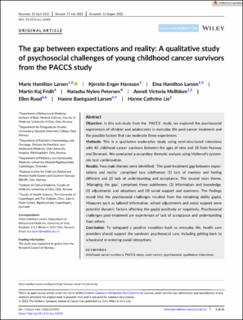| dc.contributor.author | Larsen, Marie Hamilton | |
| dc.contributor.author | Hansson, Kjersti Enger | |
| dc.contributor.author | Larsen, Elna Hamilton | |
| dc.contributor.author | Fridh, Martin Kaj | |
| dc.contributor.author | Petersen, Natasha Nybro | |
| dc.contributor.author | Mellblom, Anneli | |
| dc.contributor.author | Ruud, Ellen | |
| dc.contributor.author | Larsen, Hanne Baekgaard | |
| dc.contributor.author | Lie, Hanne Cathrine | |
| dc.date.accessioned | 2022-12-23T12:41:37Z | |
| dc.date.available | 2022-12-23T12:41:37Z | |
| dc.date.created | 2022-08-30T09:08:27Z | |
| dc.date.issued | 2022 | |
| dc.identifier.issn | 0961-5423 | |
| dc.identifier.uri | https://hdl.handle.net/11250/3039408 | |
| dc.description.abstract | Objective: In this sub-study from the ‘PACCS’ study, we explored the psychosocial
experiences of children and adolescents in everyday life post-cancer treatment and
the possible factors that can moderate these experiences.
Methods: This is a qualitative explorative study using semi-structured interviews
with 43 childhood cancer survivors between the ages of nine and 18 from Norway
and Denmark. We conducted a secondary thematic analysis using Malterud's systematic
text condensation.
Results: Two main themes were identified: ‘The post-treatment gap between expectations
and reality’ comprised two subthemes: (1) lack of mastery and feeling
different and (2) lack of understanding and acceptance. The second main theme,
‘Managing the gap’, comprised three subthemes: (1) information and knowledge,
(2) adjustments and adaptions and (3) social support and openness. The findings
reveal that the psychosocial challenges resulted from the remaining ability gap(s).
Measures such as tailored information, school adjustments and social support were
potential dynamic factors affecting the gap(s) positively or negatively. Psychosocial
challenges post-treatment are experiences of lack of acceptance and understanding
from others.
Conclusion: To safeguard a positive transition back to everyday life, health care
providers should support the survivors' psychosocial care, including getting back to
school and re-entering social interactions. | en_US |
| dc.language.iso | eng | en_US |
| dc.rights | Navngivelse-Ikkekommersiell 4.0 Internasjonal | * |
| dc.rights.uri | http://creativecommons.org/licenses/by-nc/4.0/deed.no | * |
| dc.subject | Kreft | en_US |
| dc.subject | Barn | en_US |
| dc.title | The gap between expectations and reality: A qualitative study of psychosocial challenges of young childhood cancer survivors from the PACCS study | en_US |
| dc.title.alternative | The gap between expectations and reality: A qualitative study of psychosocial challenges of young childhood cancer survivors from the PACCS study | en_US |
| dc.type | Peer reviewed | en_US |
| dc.type | Journal article | en_US |
| dc.description.version | publishedVersion | en_US |
| dc.source.journal | European Journal of Cancer Care | en_US |
| dc.identifier.doi | https://doi.org/10.1111/ecc.13696 | |
| dc.identifier.cristin | 2046988 | |
| cristin.ispublished | true | |
| cristin.fulltext | original | |
| cristin.qualitycode | 1 | |

